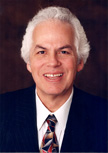Stanley B. Prusiner, M.D.
 Stanley B. Prusiner, M.D., is Director of the Institute for Neurodegenerative Diseases and Professor of Neurology and Biochemistry at the University of California, San Francisco where he has worked since 1972. He received his undergraduate and medical training at the University of Pennsylvania and his postgraduate clinical training at UCSF. From 1969-72, he served in the U.S. Public Health Service at the National Institutes of Health. Editor of 12 books and author of over 330 research articles, Prusiner’s contributions to scientific research have been internationally recognized.
Stanley B. Prusiner, M.D., is Director of the Institute for Neurodegenerative Diseases and Professor of Neurology and Biochemistry at the University of California, San Francisco where he has worked since 1972. He received his undergraduate and medical training at the University of Pennsylvania and his postgraduate clinical training at UCSF. From 1969-72, he served in the U.S. Public Health Service at the National Institutes of Health. Editor of 12 books and author of over 330 research articles, Prusiner’s contributions to scientific research have been internationally recognized.
Prusiner is a member of the National Academy of Sciences, the Institute of Medicine, the American Academy of Arts and Sciences, the American Philosophical Society, and is a foreign member of the Royal Society, London. He is the recipient of numerous prizes, including the
- Potamkin Prize for Alzheimer’s Disease Research from the American Academy of Neurology (1991);
- the Richard Lounsberry Award for Extraordinary Scientific Research in Biology and Medicine from the National Academy of Sciences (1993); the Gairdner Foundation International Award (1993);
- the Albert Lasker Award for Basic Medical Research (1994);
- the Paul Ehrlich Prize from the Federal Republic of Germany (1995);
- the Wolf Prize in Medicine from the State of Israel (1996);
- the Keio International Award for Medical Science (1996);
- the Louisa Gross Horwitz Prize from Columbia University (1997);
- and the Nobel Prize in Physiology or Medicine (1997).
In 2001, Prusiner founded InPro Biotechnology Inc., which is devoted to commercializing some of the discoveries that he and his colleagues have made at the University of California. Prusiner holds more than 35 issued or allowed United States patents all of which are assigned to the University of California and many of which are licensed to InPro Biotechnology.
Contributions
Stanley Prusiner discovered an entirely new class of pathogens that replicate without nucleic acid. Through this work, he created a new field of research that has resulted in significant progress in understanding degenerative diseases of the central nervous system (CNS). His revolutionary studies have made conceptual advances in elucidating mechanisms of age-dependent CNS diseases.
For several decades, the prevailing concept was that scrapie, a nervous system disease of sheep, is caused by a slow-acting virus. In 1982, Prusiner proposed that scrapie is caused by an infectious protein that he called a “prion”. Despite considerable experimental data arguing for the existence of prions, many scientists thought Prusiner’s ideas were heretical. Over the next decade, Prusiner and others accumulated a wealth of data demonstrating how an infectious pathogen devoid nucleic acid can multiply and cause CNS degeneration.
After purifying prions from the brain, Prusiner discovered that they are composed of a single protein, which he called “prion protein,” or PrP. Prusiner found that a fragment of the protein polymerizes into amyloid; next, he and his colleagues demonstrated that amyloid plaques in the brains of animals and humans dying of prion diseases are composed of PrP. This was the first time that cerebral amyloid was shown to be the cause of a CNS disease.
Prusiner and his colleagues discovered that the disease causing form of PrP was derived from a normal cellular protein, which is encoded by a chromosomal gene found in all animals. Next, they determined that the tempo of scrapie in animals is controlled by the PrP sequence and that the human diseases Gerstmann-Sträussler-Scheinker and familial Creutzfeldt-Jakob (CJD) are caused by mutations in the PrP gene. This work identified the first mutations causing a CNS degenerative disease.
Transgenic mice expressing PrP with a mutation causing inherited human prion disease developed neurodegeneration spontaneously. The brains from these mice transmitted disease to inoculated recipients revealing how an illness can be both inherited and infectious, an unprecedented concept in the study of disease pathogenesis. Equally important, the prion concept explained how the same disease process could also account for the sporadic or spontaneous form of the disease, which is the most common type in humans.
Unable to find a chemical difference that distinguished cellular PrP from scrapie PrP, Prusiner and his colleagues demonstrated that the two PrP forms have different conformations, or shapes. The structural transition that PrP undergoes when it changes from a normal benign protein into a deadly rogue molecule is the fundamental event underlying the pathogenesis of all prion diseases. Recently, Prusiner and his colleagues showed that a synthetic peptide corresponding to about one fourth of PrP can be turned into an artificial prion when folded into a particular conformation.
Four years after Prusiner discovered prions, mad cow disease or bovine spongiform encephalopathy (BSE) was discovered in cattle in Britain and found to be caused by prions. Tracking BSE and the human form called variant CJD has been possible because of Prusiner’s discovery of the disease causing form of PrP.
The unprecedented findings of Prusiner and his many very talented colleagues have significantly changed the way scientists and physicians think about CNS degenerative diseases. Once considered heresy by many scientific scholars, prions are now widely accepted as orthodoxy.